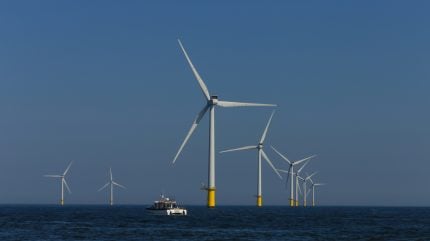
With a projected lifespan of 20–25 years, the UK’s earliest offshore wind farms are currently entering the final stages of their operational life and questions remain as to what needs to be done when this happens – and what direction the UK’s energy mix will take.
Since 2003, 14.7GW of offshore wind has been installed. In 2023, wind provided around 27% (touching 30% recently) of Britain’s electricity. More than one-third of the UK’s offshore wind farms will reach the end of their original operational design life by 2035.
A new report from RenewableUK outlines recommendations on what the UK should do once these offshore wind farms reach the end of their lifespans, and calls for the UK Government to clarify its policies.
The report, titled ‘Developing effective end of-life policy frameworks for UK offshore wind’, claims that without further clarification the UK could lose 5GW of offshore wind by 2035 – enough to power nearly four million homes.
The report identifies five key challenges for end-of-life scenarios for offshore wind farms that the UK Government and regulators must address: decommissioning, financial certainty, lifetime extension, repowering and establishing a clear offshore transmission owners framework for end-of-life.
This comes at a time when wind power has become a global talking point. As most western nations look to diversify their energy sources, and move away from hydrocarbons, US President Donald Trump has been outspoken about his dislike of wind power.
In fact, the suspension of offshore wind leasing by the incoming president has significantly impacted European wind power companies.
On the first day of his second term in office, Trump halted new federal offshore wind leasing pending economic and environment review. This decision has led to a decline in the share prices of several European companies involved in the wind power sector.
The UK is transitioning away from North Sea drilling for oil and gas, a process that began to accelerate after the election last summer of a Labour Government, which made clear manifesto promises to move the UK away from hydrocarbons.
However, Labour’s policies have prompted several oil and gas (O&G) companies to scale back their operations in the region; for example, US operator APA announcing plans to exit the area in 2029. Trump has also explicitly urged the UK to step away from its ambition to scale up wind power and focus instead on oil production in the North Sea.
RenewableUK’s report states that “clear direction and leadership are needed” on how decommissioning should commence if the lifespan of these farms is not extended.
The repowering of offshore wind assets could be a key opportunity to maximise increasingly limited seabed resources and retain vital generation capacity. Repowered projects deliver more efficient and resilient assets at sites with favourable seabed conditions and existing infrastructure.
Recent research by climate campaign group Uplift indicated that that UK’s North Sea O&G companies are failing to switch their investments to renewable energy.
According to the organisation, most offshore O&G companies operating in the UK are not redirecting their investments away from fossil fuels, despite the industry’s assertions that it is leading the country’s energy transition.
Only seven of the 87 offshore O&G companies are projected to invest in renewable energy by 2030, Uplift said.
The UK Government has pledged to ban the issuance of new licences for O&G fields in the North Sea, although existing fields will be permitted to continue operating.
Before the July 2024 election, the Labour Party also announced plans to implement a new windfall tax on O&G companies. The Effective Petroleum Tax Rate (EPL) will raise taxes for these companies by 3% on 1 November.



